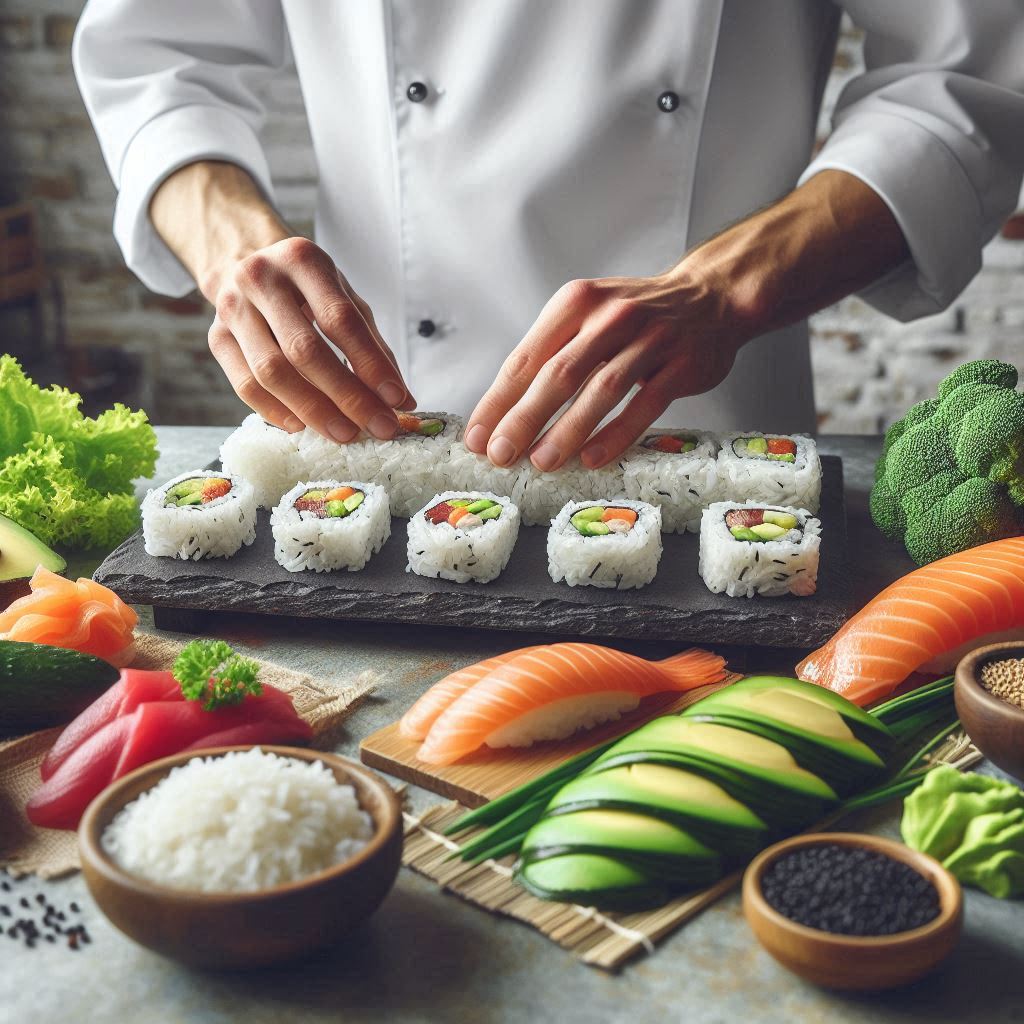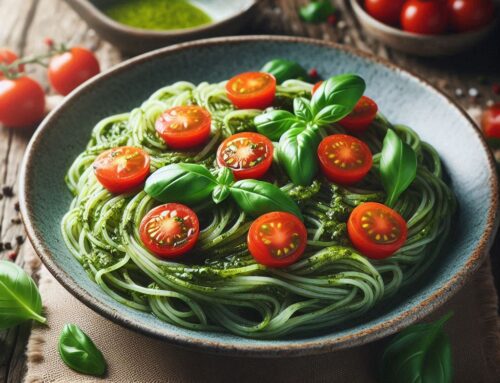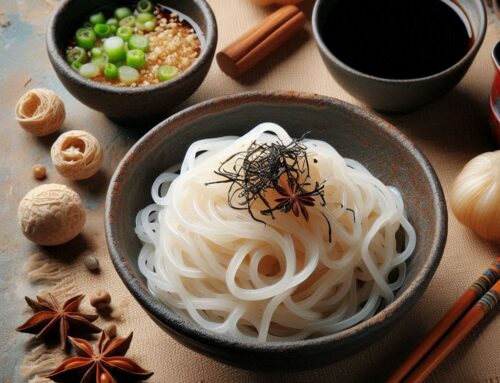
Introduction: The Rise of Konjac Rice in Sushi Making
As the culinary world continues to innovate, sushi enthusiasts are increasingly turning to healthier alternatives without sacrificing taste. One such innovation making waves is the use of konjac rice in sushi making. This unique ingredient is transforming traditional sushi dishes into low-carb, nutritious options that cater to a growing demand for health-conscious meals.
Konjac rice, derived from the konjac plant native to Asia, is celebrated for its remarkable health benefits. It is incredibly low in calories and carbohydrates, making it an ideal choice for those seeking low-carb sushi alternatives. Additionally, konjac rice is high in dietary fiber and has been linked to various health benefits such as improved digestion and better blood sugar control.
Incorporating konjac rice into sushi not only offers a healthier twist but also maintains the beloved texture and flavor profile that sushi lovers crave. As more people become aware of these benefits, sushi with konjac rice is rapidly gaining popularity as a delicious and guilt-free option on menus around the world. Whether you’re a seasoned sushi aficionado or new to this culinary delight, exploring healthy sushi options like those made with konjac rice can be both satisfying and beneficial for your well-being.
What is Konjac Rice and Why Use it for Sushi?
Konjac rice, often hailed as a revolutionary alternative to traditional rice, is gaining popularity among health enthusiasts and culinary experts alike. Derived from the konjac plant, this rice substitute is known for its unique properties that make it an excellent choice for various dishes, including sushi.
One of the standout features of konjac rice is its impressive dietary fiber content. Unlike regular rice, konjac rice is incredibly low in calories and carbohydrates while being rich in glucomannan—a type of soluble fiber. This makes it an ideal option for those looking to manage their weight or control blood sugar levels without sacrificing the joy of eating sushi.
So why use konjac in sushi? The answer lies not only in its health benefits but also in its texture and versatility. Konjac rice has a slightly chewy consistency that mimics traditional sushi rice well enough to satisfy even the most discerning palates. It absorbs flavors beautifully, ensuring that each bite of your sushi roll bursts with taste.
Moreover, incorporating konjac rice into your diet can offer numerous health benefits beyond just being a dietary fiber-rich substitute. It can aid digestion, promote satiety by keeping you fuller longer, and support overall gut health—making it a smart choice for those seeking nutritious alternatives without compromising on flavor or satisfaction.
In summary, whether you’re looking to enhance your diet with more fiber or simply want to try something new with your sushi recipes, konjac rice presents a compelling case as both a healthy and delicious option worth exploring.
Essential Ingredients and Tools for Making Sushi with Konjac Rice
Creating sushi with konjac rice is a delightful culinary adventure that combines traditional techniques with a modern twist. To embark on this journey, you’ll need to gather the essential ingredients and tools that ensure a seamless sushi-making experience.
Ingredients List for Sushi with Konjac Rice:
- Konjac Rice: The star of this dish, konjac rice offers a low-calorie and gluten-free alternative to traditional sushi rice while maintaining the desired texture.
- Nori Sheets: These seaweed sheets provide the classic outer layer for your sushi rolls, adding both flavor and structure.
- Fresh Fish or Vegetables: Whether you prefer tuna, salmon, avocado, or cucumber, fresh fillings are crucial for authentic taste and texture.
- Rice Vinegar: This ingredient is key for seasoning the konjac rice to give it that distinctive tangy flavor associated with sushi.
- Soy Sauce and Wasabi: Essential condiments that accompany your finished rolls perfectly.
- Pickled Ginger: Often served as a palate cleanser between different types of sushi pieces.
Sushi-Making Tools:
- Bamboo Sushi Mat (Makisu): This tool is indispensable for rolling your sushi tightly and evenly without causing damage to the nori sheet or fillings.
- Sharp Knife (Yanagiba): A high-quality knife ensures clean cuts through both the nori sheet and fillings without tearing them apart.
- Wooden Mixing Bowl (Hangiri): Traditionally used to mix vinegar into cooked rice; it helps absorb excess moisture from the konjac rice as well.
- Rice Paddle (Shamoji): Useful for spreading seasoned konjac rice over nori sheets evenly without sticking too much due to its non-stick surface design.
- Cutting Board: A sturdy base is necessary when slicing through your rolled creations into bite-sized pieces ready for serving!
By assembling these ingredients and tools in advance, you’ll be well-prepared to craft delicious sushi rolls featuring nutritious konjac rice—a perfect blend of tradition meeting innovation in culinary arts!
A Step-by-Step Guide to Preparing Perfect Sushi Rolls with Konjac Rice
Creating perfect sushi rolls with konjac rice is an art that combines precision and creativity. This step-by-step guide will walk you through the process, ensuring delicious and visually appealing sushi every time.
Step 1: Gather Your Ingredients and Tools
Before you begin, ensure you have all necessary ingredients: fresh fish or vegetables of your choice, nori sheets, and konjac rice. You’ll also need a bamboo sushi mat, a sharp knife, and a bowl of water for dipping your fingers to prevent sticking.
Step 2: Prepare the Konjac Rice
Konjac rice is an excellent low-calorie alternative to traditional sushi rice. To prepare it, rinse thoroughly under cold water to remove any natural odor. Then cook according to package instructions until tender but firm.
Step 3: Lay Out the Nori Sheet
Place a sheet of nori on the bamboo mat with the shiny side facing down. Make sure it aligns with the edge of your mat for even rolling.
Step 4: Spread the Konjac Rice Evenly
Dip your fingers in water and spread a thin layer of konjac rice over two-thirds of the nori sheet. Be gentle to avoid tearing the seaweed. Leave about an inch at one end free from rice for sealing purposes.
Step 5: Add Fillings Carefully
Arrange your chosen fillings in a horizontal line across the center of the rice-covered area. Be mindful not to overstuff as this can make rolling difficult.
Step 6: Roll Your Sushi Like a Pro
Using both hands, lift the edge of the bamboo mat closest to you while holding down the fillings with your fingers. Roll tightly away from you until you’ve reached that one-inch strip without rice. Use gentle pressure throughout this process for uniformity.
Step 7: Seal and Slice Your Roll Perfectly
To seal, dampen that exposed strip lightly with water then complete rolling until sealed shut firmly by applying slight pressure along its length using both hands on top of wrapped roll still within its bamboo cocoon! Now slice into bite-sized pieces using swift clean cuts – remember wetting blade between each cut helps maintain neat edges!
By following these detailed steps on how-to-roll-sushi-with-konjac-rice precisely yet creatively – voila! You now possess skills needed crafting delightful homemade rolls impressing family friends alike!
Tasty Variations: Creative Fillings and Toppings for Your Sushi Rolls
Sushi rolls offer a versatile canvas for culinary creativity, allowing you to experiment with a variety of fillings and toppings that can elevate your dining experience. When it comes to sushi roll fillings, the possibilities are endless. Traditional ingredients like fresh tuna, salmon, and avocado can be combined with more adventurous options such as spicy crab mix or marinated tofu for a unique twist.
For those using konjac rice in their sushi creations—a popular choice for its low-calorie and health benefits—selecting the best toppings is essential to complement its subtle flavor. Consider topping your konjac rice sushi rolls with thinly sliced mango or pickled ginger to add a sweet and tangy contrast. Sprinkling sesame seeds or tobiko (fish roe) not only enhances the visual appeal but also adds an extra layer of texture.
Creative sushi recipes don’t stop at just fillings and toppings; incorporating unique sauces like spicy mayo or eel sauce can further enrich the taste profile of your rolls. Whether you’re hosting a sushi night at home or simply looking to diversify your meal prep routine, experimenting with different combinations will ensure that each bite is as delightful as it is delicious.
Tips and Tricks to Enhance Your Sushi-Making Experience
Creating sushi at home can be an exciting culinary adventure, but mastering the art requires attention to detail and practice. Here are some essential tips and tricks to enhance your sushi-making experience, ensuring that each roll is as delicious as it is beautiful.
First, focus on perfecting your homemade sushi technique by starting with the basics: rice preparation. When using konjac rice as a base for your sushi, it’s crucial to rinse it thoroughly before cooking to remove any excess starch. This helps achieve the desired sticky consistency that’s vital for holding your rolls together.
One common mistake to avoid in making konjac rice sushi is overlooking the importance of seasoning. Properly seasoned rice should have a balance of vinegar, sugar, and salt; this enhances the flavor profile of your sushi without overpowering the delicate taste of fish or vegetables.
Another key aspect of successful sushi preparation is choosing fresh, high-quality ingredients. Whether you’re working with seafood or vegetarian options, freshness will significantly impact the overall taste and texture of your rolls. Remember that less can often be more when it comes to fillings—overstuffing can cause rolls to fall apart.
Finally, practice makes perfect! Don’t be discouraged by initial challenges; instead, use them as learning opportunities to refine your technique over time. With patience and these handy tips in mind, you’ll soon find yourself creating restaurant-quality sushi right in your own kitchen.
The Nutritional Benefits of Using Konjac Rice in Your Diet
Konjac rice, often hailed as a superfood, is gaining popularity among health enthusiasts for its remarkable nutritional benefits. Derived from the konjac plant, this rice alternative is particularly appealing to those seeking a low-calorie and diet-friendly option. One of the primary health benefits of using konjac in meals is its incredibly low calorie content compared to regular rice. While traditional white rice contains about 130 calories per 100 grams, konjac rice boasts only around 10 calories for the same amount, making it an excellent choice for those on a calorie-conscious diet.
In addition to being low in calories, konjac rice is rich in dietary fiber, specifically glucomannan. This soluble fiber helps promote a feeling of fullness and can aid in weight management by reducing overall calorie intake. The high fiber content also supports digestive health by promoting regular bowel movements and maintaining gut health.
When comparing the nutritional profile of regular rice with konjac rice, it’s clear that konjac offers unique advantages. Regular rice provides carbohydrates as its main nutrient source but lacks significant amounts of fiber or other beneficial compounds found in konjac. As such, incorporating konjac into your diet can help balance your nutrient intake while supporting weight management goals.
Overall, adopting konjac rice as part of your meals not only contributes to a healthier lifestyle but also provides an easy way to enjoy satisfying dishes without compromising on taste or nutrition.






